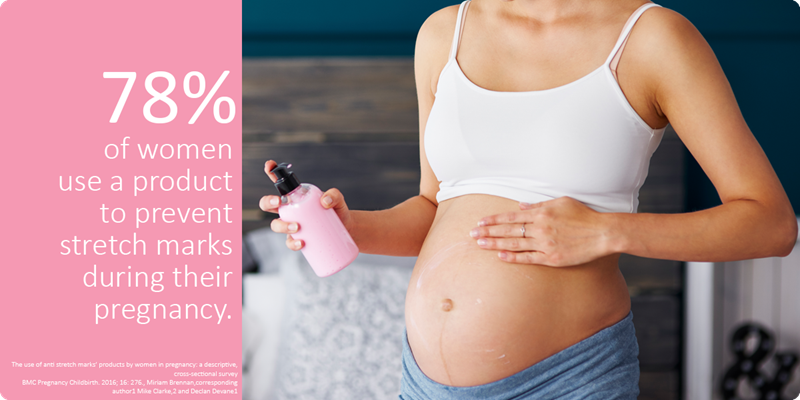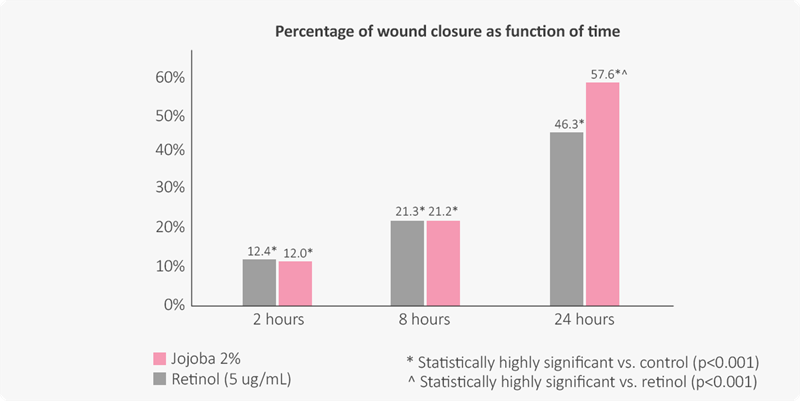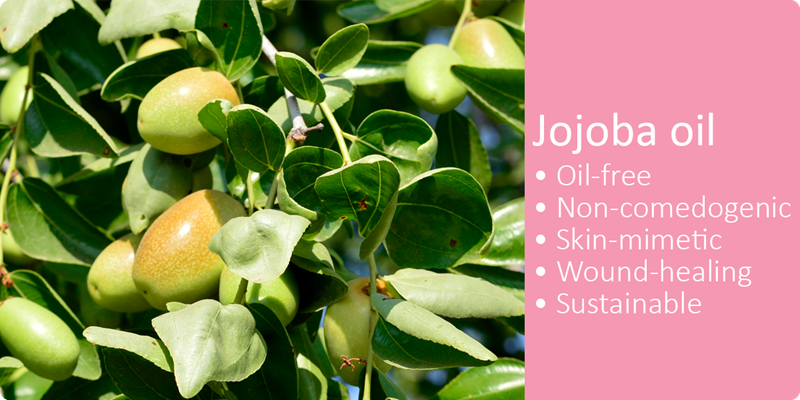Stretch Marks are More Common Than You Thought
Stretch marks are a topic that has come up a lot recently from our customers. This shouldn’t come as a surprise when you know that they affect 80% of the adult population, both female and male. Also called striae distensae, stretch marks are a form of scarring on the skin, that display an off-color hue and altered texture. They appear during rapid growth of the body, which cause a tearing of the dermis, and really never disappear. Stretch marks are very often associated with pregnancy, but also frequently happen during rapid body changes (think puberty) and are not unfamiliar to extreme body-builders who undergo accelerated growth due to weight and muscle gain.
So, what really happens in your skin that causes such a traumatic reaction? There a two main driving forces here: the first one is mostly physical, due to the rapid stretching of the skin causing changes in the cytoskeleton and expression of components of the extracellular matrix. This leads to disoriented dermal fibers and atrophy of the epidermis. In the cases where hormonal changes are also involved (pregnancy for instance), some researchers also see the increased production of estrogen as possibly leading to an increase in Matrix Metalloproteinases (MMPs). These enzymes are in turn responsible for an unusually high rate of collagen and elastin breakdown, further depriving skin from the fundamental structural network that provides its integrity and leading to local inflammation and cellular oxidation. [1], [2], [3], [4], [5], [6], [7], [8], [9]
Stretch marks are an emotional and beautiful symbolic part of the human body, and reactions toward them can greatly vary from one individual to another. Some people will gladly embrace them, and others might be looking for cosmetic solutions to decrease their visibility. While the leading causes for stretch mark formation haven’t been clearly identified, their general prevalence in the population, combined with the emotional impact these visible scars can bring has driven the interest in finding solutions aimed at alleviating them for cosmetic purposes. Some solutions have been identified to help reduce their appearance: collagen-stimulating ingredients, retinoids especially, used during the active phase (right after development of the immature striae, or striae rubra) can help mitigate the metabolic pathway at the origin of stretch marks. This class of molecules however are known for their potential irritancy and might not be suited for all skin types. Additionally, retinoids are often strongly advised against during pregnancy, which has led us to discuss with formulators: are there stretch mark treatment alternatives out there, more suitable for sensitive skin and at-risk populations? Vantage teams started looking for inspiration in nature…
We put jojoba oil to the test
After reviewing existing data and research, Jojoba oil was selected for the study. Scientific literature contains plenty of evidence about the efficacy of jojoba oil for moisturization and overall skin improvement, likely due to its unique liquid wax ester composition and rich content in primary and secondary metabolites. Our technical team designed a plan to study the efficacy of jojoba oil on wound healing, whose mechanism of action can be compared to the one involved in stretch mark formation. For the first part of the test, a gene expression study was performed, which involved 36,000 transcripts and variants. The second part of the test involved a fibroblast scratch test, where both jojoba oil and retinol were put to test.
a-Gene Expression study results
0.3% of jojoba oil was used on a reconstructed model. The gene expression study showed 32 genes being upregulated and 30 genes downregulated, versus non-treated material. Scientists extracted the genetic data related to the biological pathways involved in the formation of stretch marks. In particular, 3 key areas were highlighted:
- Extra cellular matrix: Jojoba upregulated IGFBP5 and DNC genes, which are expected to help in the assembly of the extracellular matrix. [10], [11]
- Cytoskeleton assembly: Jojoba oil upregulated ANLN, which is believed to regulate the assembly of the actomyosin cytoskeleton. It also downregulated ACTN1 and MAP4, which could lead to loosened bundling of tubulin and to loosened fibroblast fibers, helping with the overall recovery of skin flexibility and smoothness. [12], [13]
- Inflammatory pathway: Jojoba oil downregulated the expression of KLK8/9, KLK12, VWF and IL1α, which are involved in the innate immune system response. The downregulation of their activity should lead to decreased local inflammation. [14], [15], [16]
b-Fibroblast scratch test
During this test, jojoba oil at 2% was used on a human skin fibroblast monolayer culture. The culture was scratched, and wound width measurements were taken at 0, 2, 8 and 24 hours. Jojoba was tested against retinol (positive control) and untreated cells (negative control).
These results are extremely encouraging and open the door for numerous new opportunities for the use of jojoba in would healing treatments, stretch mark treatments, and cosmetics/treatments targeted for diabetic patients. Additional clinical studies are being carried out to further determine all the potential benefits that jojoba brings into personal care formulations.
As the leader in jojoba oil and derivatives, Vantage has created many formats to deliver this ingredient in cosmetic formulations: golden and colorless jojoba oil, encapsulated jojoba in Lipobead™ or Liposphere™ technologies, Iso Jojoba™ Butters, jojoba oil captured in the nano-emulsion of DW Jojoba Milk, and more.
Contact us today for more details on our on-going studies on jojoba oil.
References
[1] Lee KS, Rho YJ, Jang SI, Suh MH, Song JY., Decreased expression of collagen and fibronectin genes in striae distensae tissue. (Clin Exp Dermatol. 1994 Jul;19(4):285-8)
[2] Shuster S., The cause of striae distensae . (Acta Derm Venereol Suppl ( Stockh ). 1979;59(85):161-9)
[3] Lung PW, Tippavajhala VK, de Oliveira Mendes T, Téllez-Soto CA Schuck DC Brohem CA Lorencini M Martin AA, In vivo study of dermal collagen of striae distensae by confocal Raman spectroscopy. (Lasers Med Sci. 2018 Apr;33(3):609-617)
[4] Rolfe H, Wurm E, Gilmore S., An investigation of striae distensae using reflectance confocal microscopy. ( Australas J Dermatol. 2012 Aug;53(3):181-5)
[5] Bertin C, Lopes-DaCunha A, Nkengne A, Roure R, Stamatas GN., Striae distensae are characterized by distinct microstructural features as measured by non invasive methods in vivo. (Skin Res Technol. 2014 Feb ;20(1):81-6)
[6] Inflammation in Striae distensae Dermatopathology: Practical & Conceptual, Jul Sep 1997, Vol. 3, No. 3
[7] Topical management of striae distensae (stretch marks): Prevention and therapy of striae rubrae and albae . Journal of the European Academy of Dermatology and Venereology
[8] Contractile forces generated by striae distensae fibroblasts embedded in collagen lattices. Arch Dermatol Res. 2005 Jul;297(1):10 7.
[9] Matrix Metalloproteinases in Normal Pregnancy and Preeclampsia, Juanjuan Chen and Raouf A. Khalil, Prog Mol Biol Transl Sci. 2017; 148: 87–165.
[10] IGFBP 5 Promotes Fibrosis via Increasing Its Own Expression and That of Other Pro fibrotic Mediators. Frontiers in endocrinology (2018) 9 , 601.
[11] Targeted disruption of decorin leads to abnormal collagen fibril morphology and skin fragility. J Cell Biol . 1997;136(3):729 743.
[12] The myriad roles of Anillin during cytokinesis, Seminars in Cell & Developmental Biology, Volume 21, Issue 9, 2010, Pages 881 8 91
[13] Contractile forces generated by striae distensae fibroblasts embedded in collagen lattices. Arch Dermatol Res. 2005 Jul;297(1):10 7
[14] Protease activated receptors and itch. Handbook of experimental pharmacology , (2015) 226 , 219 235.
[15] Von Willebrand factor and inflammation. J Thromb Haemost . 2017 Jul;15(7):1285 1294
[16] Interleukin 1 α and the inflammatory process. Nature immunology , (2016) 17 (8), 906 913. doi:10.1038/ni.3503
[17] Topical retinoid improves early stretch marks. Archives of dermatology. (1996) 132. 519 26.


